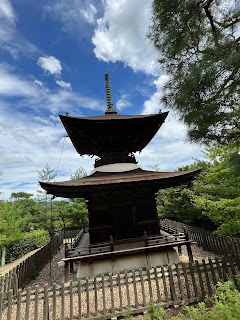We spent Thursday, Aug. 31 and Friday in Kyoto.
On Thursday, we headed to Saga Arashiyama. Our destinations included the Bamboo forest, the Tenryuji Temple and garden and Jōjakkōji Temple.
It was shaping up to be another hot day. That likely meant we would be limited in what we might have energy to see.
I noticed on Google maps (this was an indispensable tool on the trip) that JR West had a station at our destination. Co-incidentally the Kyoto Subway’s Tozai line, it stopped right outside our hotel, had a connecting stop at Nijo. It was six stops away. We loaded our backpacks with water, towels and other necessities and headed out.
The Nijo JR station seemed to be new. It had an interesting wooden shelter over the platform.
 |
| Walking toward the platform shelter, trying to get out of the sun. |
 |
| Spectacular truss work under the platform roof. Note the vending machine in the lower right. They’re all over the place. |
The ride to Saga Arashiyama was just three stops.
 |
| The train that took us to Saga Arashiyama departs. Hmm, looks like I took another picture of my finger. |
 |
| Looking down the tracks before leaving the station. It turned out to be a beautiful hot day. |
 |
| At the Tenryuji Temple |
 |
The garden behind the Tenryuji Temple. It is hundreds of years old.  | | Touring the inside of the temple. You have to take your shoes off. |
 | Another shot of the garden. What’s not evident is that the temple property is in a suburb of Kyoto. There was a road right behind the garden. You’d never know it. The landscape was really serene.
 | | Another shot of the garden. I liked how I was able to frame the red branches of the maple in the background. I realized that this place has been so widely photographed that there’s no way that any that I took were original. It’s still fun to try. |
After looking at the gardens and touring the temple. We headed toward the bamboo forest. I’m used to the amazing redwood forests we have here. The bamboo forest was equally awe inspiring, but different. Everything is vertical, but no branches on the trees until you get to the top of the canopy.
We walked through the forest, heading toward another temple. But didn’t find it and settled on the Jōjakkōji Temple. This part of Kyoto was festooned with temples and shrines.
The Jōjakkōji Temple is built on a hillside. The saving grace is that on this hot day its in a forested area. That made the visit relatively cooler. I was amused by the two-story pagoda and had to get a picture. It filled my pagoda quota.
|
|
Having gotten our fill of religious buildings we looked for some lunch. Down the street leading to the temple we found a tasty soba restaurant. It was air conditioned, too. Even so, we were pretty wiped out.
From there, we headed back to town and the train back to the hotel.
 |
| The train back to Nijo |
 |
One of my favorite signs on a Japanese train. They don't want to set expectations too high. :)
So, we get back to Nijo, exit the station and found the Kyoto Fire Department out doing an inspection. At least that's what I think they were doing.
|
And then I found two more vending machines. I'm impressed that you can buy a bowl of ramen from a machine and a fried noodle pancake. If it had not been so hot out, I might have tried the ramen. I wonder how it compares to "Top Ramen"?
 |
| A bowl of vending machine ramen sets you back 1,000 yen |
 |
Next to it is a machine selling fried noodle pancakes. 900 yen.
|
From Nijo, we grabbed the subway back to the hotel and cooled off in the swimming pool. (Nope, no pictures.)
In Part 2, we visited the Kyoto Railway Museum.
# # #


















Comments
Post a Comment